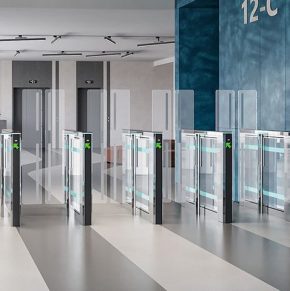
Stannah: Building regulations – key guidance for lifts
Stannah has produced a handy overview to the key acts, regulations and standards that outline best practice around lifts – ensuring any commercial/public building is accessible and efficient when moving people.
Introduction
There are three main items that outline the best practice for making a commercial/public building accessible…
– The legal framework, the Equality Act
– The building regulations, Part M Vol.1 & Vol.2 and Part B or Section 4 of the Technical handbook (Scottish Part M Equivalent)
– The design guidance, the recently updated British Standard BS 8300: 2018 – Part 1 & 2.
These all help to outline the legal requirements, what lift to consider in a new building and the preference and guidance on ensuring an accessible lift. The later two highlight specific lift requirements and preferences between the different types of passenger moving lifts.
1. Equality Act 2010… the legal bit
Sometimes, a physical feature of a building (or other premises) can make it more difficult for a person with impaired mobility to access. The Equality Act 2010 (formerly DDA) states that if you’re place someone at a substantial disadvantage, you have a legal duty to make reasonable adjustments. This is where a lift can play a part.
It’s possible to install one or more disabled access lifts in most buildings that have two or more floors, or to provide a ramp or step lift where there is a short flight of stairs. Any lift adds value to the commercial property it’s placed in by speeding up the movement of people up and down the building, and helps the building owner meet the requirements of the Act.
For both new and existing buildings we look to Building Regulations to give instruction on the best lift selection and the specific requirements to comply and the guidance of BS 8300:2018 Design of an accessible and inclusive built environment to selecting and creating an accessible lift .
2a. Part M & Part B… the regulations in England & Wales
The Building Regulations, Approved Document M (Part M) gives direction on enabling a public access building to conform to the Equality Act. This public access regs document states that reasonable provision must be made for people to gain access to and use the building’s facilities.
Fire Safety: Approved Document B is the building regulation in England which covers all fire safety matters within and around buildings as well as further detail on firefighting and evacuation passenger lifts.
In summary, Part M states that the preferred solution to disabled access is a passenger lift, with the number of lifts depending upon the application, but it also recognises that it may not always be possible for a building to accommodate one so proposes the next best alternatives, namely platform lift and wheelchair platform stairlift.
2b. Section 4.2 … the regulations in Scotland
Like it’s English counterpart, Section 4.2 gives direction on enabling a public access building to conform to the Equality Act. Most of the requirements of Section 4.2 are identical or closely similar to Part M.
However the platform size requirements do differ with the Scotland document, requiring larger minimum sizes for both low and medium rise platform lifts.
Stannah offer the complete range of passenger moving lifts – passenger and platform and will always advise on the most appropriate lift for your building. Simply look at the company’s website.
3. BS 8300:2018… the design guidance
The new British Standard BS 8300: 2018 (Part 1 and 2) looks at the design of new buildings and their ability to create an inclusive environment. Both parts of BS 8300 supersede the 2009 version of this standard, which has been withdrawn.
This revised code of practice aims to give the information needed to create an inclusive environment from the outset of a project. Part 1 primarily covers access in and around the external environment and the approaches to buildings.
Part 2 provides guidance on access within buildings, including the facilities that should be provided inside buildings.
The act also states that that building design must ensure that effective barriers against smoke and fire are provided, without impeding access for all.
Moreover, in offering best-practice recommendations, this standard explains how architectural design and the built environment can help disabled people to make the most of their surroundings.
This standard strongly recommends that in multi-storey buildings, at least one lift (of sufficient size) must be made accessible to wheelchair users.
An accessible lift will need to meet the following criteria
– Can be found easily
– Is large enough for its intended use
– Leaves space outside to manoeuvre
– Is fitted with lift controls that are easily found and identifiable
– Is fitted with visual and audible signals
– Has a clear entrance of suitable width
– Is fitted with a reasonable level of lighting in the car and on all landings
– Is accurate on stopping to ensure ease of entry/exit
Summary
For any building, existing or new, it is important to consider the pieces of guidance above and we hope that this blog gives a summary on the lift requirement within them.
A reputable lift provider will be able to assist you in your decision making, however, it’s certainly worth being well-informed about these design considerations yourself.
Stannah offer a broad range of platform lift products (and passenger lifts) to enable easy vertical circulation, working with you to solve your access problem and comply to building regulations.
It’s also worth pointing out that depending on the type of lift and the specification will then define the further standards that lift falls under – for a full list of lift standards take a look at Stannah’s glossary.
Or, if you think you require a lift then, why not take a look at ‘three key considerations when choosing a people moving lift‘ or find further information on the website.
Stannah offer a wide range of lift solutions to move people and goods. With nearly 50,000 installations across the UK and over 90,000 units on our service portfolio, Stannah knows it can help, so why not get in touch.
Visit Supplier's page
Latest news

17th April 2025
Nuaire shares expertise at Specifi Mechanical Services events in 2025
Indoor air quality and ventilation manufacturing specialist Nuaire is pleased to be exhibiting at the Specifi Mechanical Services events once again in 2025.
Posted in Air Conditioning, Articles, Building Industry Events, Building Industry News, Building Products & Structures, Building Services, Exhibitions and Conferences, Facility Management & Building Services, Heating, Ventilation and Air Conditioning - HVAC, Restoration & Refurbishment, Retrofit & Renovation
15th April 2025
West Fraser: CaberDek earns top marks from Home Counties carpentry specialist
A specialist carpentry sub-contractor covering housing sites across a large swathe of the Home Counties has come to value CaberDek from the West Fraser range for a variety of reasons: not least because the high quality panel product doesn’t destroy his operatives’ electric saws!
Posted in Articles, Building Industry News, Building Products & Structures, Building Systems, Case Studies, Restoration & Refurbishment, Retrofit & Renovation, Roofs, Timber Buildings and Timber Products, Wooden products
15th April 2025
GEZE: The Role of Access Control Systems in Enhancing Building Safety
Jane Elvins, Specification and Business Development Manager at GEZE UK, delves into the role of access control systems in enhancing building safety…
Posted in Access Control & Door Entry Systems, Architectural Ironmongery, Articles, Building Industry News, Building Products & Structures, Building Services, Doors, Facility Management & Building Services, Health & Safety, Restoration & Refurbishment, Retrofit & Renovation, Security and Fire Protection
11th April 2025
Don’t Do a Dave! It’s Time to Lock FIT Show 2025 in Your Calendar!
It’s that time again – FIT Show is back! You could be forgiven for thinking there won’t be much new to see when FIT Show returns to the NEC from 29 April – 1 May. Wrong!
Posted in Articles, Building Industry Events, Building Industry News, Building Products & Structures, Building Services, Continuing Professional Development (CPD's), Exhibitions and Conferences, Information Technology, Innovations & New Products, Restoration & Refurbishment, Retrofit & Renovation, Seminars, Training
 Sign up:
Sign up: